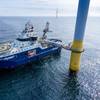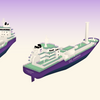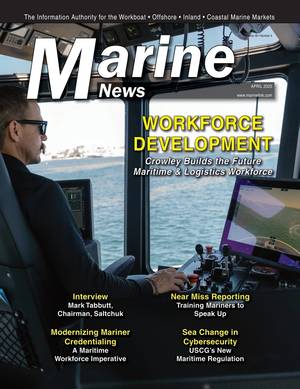Giles Candy Responds to “Getting the Numbers Right”
Wendy Laursen’s article Getting the Numbers Right, published in the August issue of Maritime Reporter, sparked debate from ballast water management experts. Here Giles Candy of Giles Environmental LLC – Independent Ballast Water Consultant, provides his feedback on the article which outlines the challenges the industry has faced trying to reduce the occurrence of invasive marine species transferred by ballast water.
Ballast water is a complex multi-faceted subject with few simple and no cheap answers – if the premise of achieving significant environmental protection is accepted.
From a water treatment point of view, the IMO’s D-2 standard is Very tough. To get a ballast water management system (BWMS) to work in the huge variance of ballasted waters, in the confines and resource restrictions of a ship, is an achievement. A successful (D-2) BWMS is a high-performance system – it is going to be expensive and need looking after.
Yes, there were 80 or so type approved BWMS in a 15+ year span, a lot of competition. BWMS were expected to be commercial for manufacturers by 2008/9. But, it was not until 2019 after a decade’s delay BWMS became mandatory and potentially commercially viable for the manufacturers. That is a long time for a company, large or small, to be supporting a slow selling, loss making, BWMS which is not used once installed – no spares to sell, no experience gained (with, as always, some exceptions).
Any development of a certified BWMS required a new multi-million-dollar type approval test and review. Improving a BWMS is extremely protracted, particularly if having to go through GESAMP (two years). It is hard to justify expensive product development and re-certification when the system is not making a profit. (I know one manufacturer spent $100,000 just on translation for a specific Flag Type Approval – try passing that cost on to the customer).
In a different world, where owners / owner associations had not almost single handedly delayed the IMO’s Ballast Water Management Convention by a decade, a world where small vessels started using systems in 2009, loads of lessons could have been learned. There would have been time and budget to develop and recertify before application of ballast water treatment to the large vessels started in 2014. In the delayed, condensed, frenetic 2019-2024 installation period, who was going to spend millions and years researching and developing better BWMS and then going through Type Approval? I understand some have, but 2009-2019, while inevitably with its issues, would have been such a more constructive implementation, not to mention environmentally protective. Owners stopped that schedule.
It’s not clear to me why limitations in the G8 Guidelines on type approval are relevant. Ballast water laws make the vessel /owner responsible for discharge compliance. If the type approval testing of the system was legal but marginal to the challenge presented by the owners trading geography, why did the owner buy the system? This is important but regularly misrepresented. It does not matter if the Type Approval yardstick is the G8 Guidelines, Revised G8 or USCG. The owner is responsible for discharge compliance (fair or not is irrelevant to this conversation).
If the vessel trades in the Caribbean they should not have to buy a BWMS capable of chewing through Shanghai, Rotterdam or Hamberg waters. But if they trade to challenging waters and purchased a BWMS which barely crawled over the type approval testing thresholds – isn’t that on the owner? Again, if compliance meant anything, price, price and price (there were 80 systems competing) would not be the primary BWMS purchasing criteria, but compliance doesn’t mean anything.
Land-based testing has got to the point it is not necessarily reflective of local water. Test waters can be curated with introduced organism populations. Land-based testing requires minimum 100,000 zooplankton/m3 inlet. I have tested up to 3,300,000. Testing requires minimum of 50mg/l TSS, for good reason the voluntary “Shanghai” Filter Test uses 1,000mg/l TSS. If an owner buys a cheap BWMS tested at 5% of likely TSS load and 3% of likely zooplankton concentrations, why should they get a pass? If the vessel installed a 50ton crane and it failed in 100ton service, the vessel would be on the hook not the manufacturer.
The great improvement in BWMS commissioning testing pass rates shows that correct installation, operations and better training, will bring improved compliance longer term. Also, systems should be better supported – if there was a strong market for support they would be and in time will be, unless you purchased from a company unlikely to support their product.
But no amount of support or operational expertise will make up for the flawed decision of an owner to buy an incapable, fragile, BWMS incompatible with their trade.
Would ICS force all owners to buy the best performing BWMS whatever their trade? There is a range of capabilities within type approved BWMS – just as there is a range of capabilities with marine certified cranes or generators etc. Saying, as I heard a major CEO say recently, “I bought a BWMS with a certificate, what more do you want me to do?” is a violent misrepresentation. It is not innocent or ignorant. It is willful. Most participants in the BWM field have shortcomings but the macro environment of schedule and manufacturer economics is a function of owner (not all) caused delay. Owners do not get to point the finger.
If D-2 was enforced imagine what the discharge numbers would be? It would be zero almost all the time. Starting with 100K or millions of zooplankton/m3, no one switches on a BWMS and turns the dial to “discharge level 10 zooplankton/m3.” They turn it on and treat the water to the capability of the system. If D-2 is enforced (or even just regularly assessed), operations, experience, support and training will all improve. Then flawed, weak BWMS which fundamentally do not perform to D-2 will also become apparent.
Once those BWMS are addressed, enforcing D-2 will lead to zero almost all the time and the environmental protection intended by the ballast water laws will be achieved. Until compliance means something, it will be easier to buy a cheap BWMS and bypass it – and keep finding reasons to bypass it.











